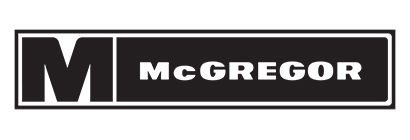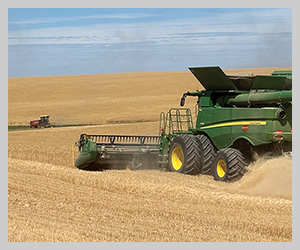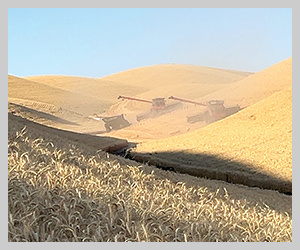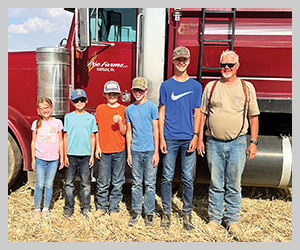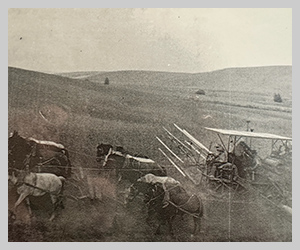Keeping the river highway open How PNWA protects Washington growers and the Columbia-Snake River supply chain
2025August 2025
By Pacific Northwest Waterways Association

Washington’s thriving wheat industry relies heavily on a critical, often unseen, transportation artery: the Columbia-Snake River System. This “river highway” is the backbone of the state’s agricultural export system, efficiently moving millions of bushels of wheat from inland grain elevators to ocean ports at Vancouver, Portland, and beyond. The efficiency of barging is unparalleled; a single, four-barge tow on the river can transport the equivalent of 538 trucks, significantly reducing fuel consumption and emissions. This method is so vital that approximately 60% of Washington’s wheat crop is shipped via this waterway. In 2023 alone, the Columbia-Snake River System transported an estimated 10.2 million tons of wheat, accounting for over 56% of all U.S. wheat exports, solidifying its status as America’s largest wheat export corridor. This river superhighway is instrumental in maintaining low transportation costs, alleviating highway congestion, and ensuring the timely delivery of Northwest grain to global markets.
Infrastructure Washington relies on
The seamless operation of this grain superhighway is contingent upon a sophisticated and meticulously maintained system of river infrastructure. From Lewiston/Clarkston to Portland, eight dams equipped with navigation locks facilitate the movement of vessels, collectively lifting them a remarkable 730 feet in elevation. The channel from the mouth of the Columbia to Portland is dredged to a depth of 43 feet to accommodate large, ocean-going ships, while upriver from Bonneville Dam, it is maintained at a minimum depth of 14 feet to support barge traffic. A network of turning basins, jetties, and locks further ensures safe and efficient navigation.
Maintaining this complex system demands continuous effort. The U.S. Army Corps of Engineers annually undertakes crucial tasks such as dredging sandbars, maintaining levees and dikes, and repairing or replacing lock gates. These efforts are vital to ensuring the river remains a dependable conduit for grain, goods, and general commerce.
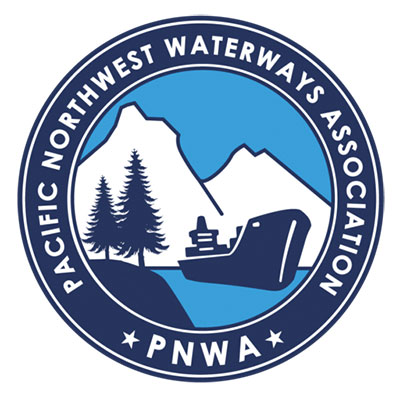
The Pacific Northwest Waterways Association (PNWA), an organization comprising farmers, ports, tow companies, and agricultural cooperatives, plays a pivotal role in securing federal support for these essential projects. Their advocacy efforts are credited with securing significant funding; for instance, Congress allocated approximately $120 million in 2023 for Columbia River maintenance, dredging, and dike repairs. PNWA emphasizes that even minor shoaling or a lock gate outage could necessitate draft restrictions, potentially stranding grain barges and resulting in tens of thousands of dollars in lost revenue for farmers. Therefore, sustained investment in locks, dredging, and port terminals is paramount to keeping the farm-to-ship supply chain flowing. A testament to this is the rapid influx of private and public investments — hundreds of millions of dollars — into new and upgraded grain terminals at Longview, Kalama, Vancouver, and Portland following the 2010 Columbia River deepening project, underscoring the confidence placed in the river’s future.
Sustaining salmon, supporting communities
The future of the Columbia-Snake River System is a subject of ongoing public discourse, with environmental and tribal groups advocating for robust salmon protections, including proposals for dam removal or breaching. In contrast, PNWA and many farmers champion a balanced, science-driven approach. They advocate for maintaining the existing dams and barge infrastructure while continuing to invest in effective fish recovery efforts. They emphasize that the river system is crucial for the region’s agriculture, navigation, and hydropower, and that any decisions regarding its future must carefully balance both ecological objectives and the economic well-being of rural communities.
Federal agencies and regional partners have already achieved substantial progress in enhancing conditions for salmon. Modern fish ladders, juvenile bypass systems, and extensive habitat restoration initiatives have contributed to historically high survival rates for young salmon migrating downstream. National Oceanic and Atmospheric Administration reports indicate that over 90–95% of juvenile Chinook and steelhead now successfully survive passage at each dam. Furthermore, investments in flow management, riparian restoration, and the reconnection of tributary habitat have significantly improved water quality and overall ecosystem health throughout the basin. These advancements demonstrate that salmon recovery and a functional river highway for commerce are not mutually exclusive but can, indeed, coexist.
PNWA remains a steadfast advocate for the navigation and agricultural communities in both policy discussions and legal proceedings. Their involvement ensures that the profound economic significance of the Columbia-Snake River System is thoroughly considered in all decisions about salmon recovery. In ongoing court cases and regional policy debates, PNWA brings the collective voice of farmers, ports, and waterway users to the forefront, underscoring that any proposal — including dam breaching — must fully account for the far-reaching impacts on rural economies, transportation infrastructure, and the livelihoods that depend on this vital river system.
Economic benefits for communities
Beyond its role in navigation, the four lower Snake River dams are a fundamental component of the region’s agricultural viability. Collectively, these dams generate nearly 1,000 megawatts of carbon-free power, sufficient to power a city the size of Seattle, and they are crucial for irrigating approximately 400,000 acres in the Columbia Basin. This reliable source of water and power is a cornerstone for regional prosperity. Furthermore, these dams facilitate the barging of about 10% of all U.S. wheat exports. Should this grain be forced to shift to trucks or rail, transportation costs could escalate by an additional $.40 to $.60 per bushel. Such an increase could severely impact profit margins, particularly in years when agricultural returns are already narrow.
Washington’s wheat industry contributes nearly $1 billion annually in production value and supports close to 19,000 jobs, encompassing every stage from the field to the port. In central Washington, irrigation within the Columbia Basin alone generates over $3 billion in annual crop value and sustains more than 13,000 farm-related jobs. The Columbia-Snake River System is the engine that makes this economic activity more reliable and affordable, preserving global competitiveness and ensuring the stability of small towns across Eastern Washington. Disrupting this waterway would not only cripple the freight system, but also undermine the entire economic framework that supports the region’s farms and way of life.
Ensuring the river stays open
For over 90 years, PNWA has been a consistent champion for this “river highway” and its diverse users. PNWA effectively unites farmers, barge operators, ports, and even utilities (which depend on hydropower) to foster common ground and advocate for sound policies. Their dedicated work in Congress and with federal agencies helps secure crucial funding for dredging, lock maintenance, and other vital upgrades. In the face of evolving weather patterns and dynamic global markets, the association also actively promotes long-term resilience, from modernizing existing dams to updating the Columbia River Treaty with Canada. Thanks to these sustained efforts, Washington agriculture’s essential waterway remains open, efficient, and competitive.
Washington’s wheat farmers can confidently rely on a consistent and efficient route to global markets for their harvests. The Columbia-Snake River System stands as an indispensable corridor, significantly reducing transportation costs, bolstering rural employment, and seamlessly connecting the state’s agricultural heartland to international buyers. As long as the barges continue their vital movement and advocates like PNWA persistently champion the system’s immense value, keeping this river highway open will remain fundamental to preserving Washington’s prominent role as a leading supplier in the global grain trade.


